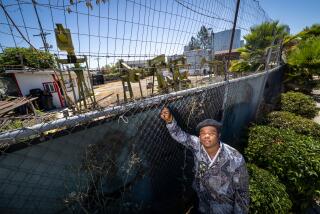Jessica Yu’s ‘Last Call at the Oasis’ made her a water activist

If you want to say that Jessica Yu burst onto the film scene in 1993 with her short “Sour Death Balls,” you’d be almost literally right. The film is almost 10 minutes of people trying to handle the disgusting confection. Yu’s work wins accolades, including a short-documentary Oscar for “Breathing Lessons,” about a writer who spent most of his life in an iron lung. Now she’s brought her California chops to bear on”Last Call at the Oasis,” a feature-length documentary on water waste, water quality and water manipulation not just here — where more than half of our drinkable public water goes to water lawns and plants outside our homes — but the whole, not-so-wet world over.
When you turn on the faucet now, do you now look at it differently?
Oh yes. I remember seeing a movie with a scene where a couple was arguing in a kitchen, and all I could see was that they left the tap running while they were arguing. I was, like, “Turn the water off, turn the water off!” I was pretty rabid for a while there.
And you practice water conservation at home?
I see it most with the kids. [My] girls basically never flush the toilet. I said, if you go to someone else’s house, it’s OK.
Growing up in California, my family was very drought-aware. I grew up smugly thinking I knew something about water issues, but really all I knew was drought. We had the bucket in the shower; my parents never wanted a lawn. The whole hillside would go brown, and we would let it.
Do we Americans indulge in magical thinking about water?
That is such a good term for it. It really is an abstraction for Americans, because we can turn on our taps and the water keeps coming out.
I was thinking a good title for the film would be “A River in Egypt,” but then I thought it’s actually not “denial.” Denial means there’s evidence you dismiss. This is not even on their radar.
We act like all we have to do is stick a straw in the ground and it’ll never end — the way Las Vegas has done with its aquifer.
That was shocking. One thing we haven’t been able to do before is measure ground water depletion on a large scale. Jay Famiglietti, the scientist at UC Irvine working with NASA and JPL to study groundwater depletion, looks at water across borders; people in different countries don’t necessarily want to share their water knowledge with their neighbors. I’ve got to say, in the film, the scientists were the unsung heroes. It’s not [in their] job description to speak out and maybe they don’t get any reward — a lot of time they get flak — but they really feel a moral obligation to say something.
You’ve undertaken some difficult documentary subjects before, like profiling a man in an iron lung. Water is real but at the same time it’s abstract.
The challenge was twofold. From a cinematic perspective, the opportunity to make a film about water is pretty irresistible. I like trying to make it a character in the film. On the other side, the complexity is pretty overwhelming. But I felt I only wanted to do it if I could tackle that complexity and get some sense of the overall picture. I didn’t know what that picture was, which made the process of researching and talking to people — that was enough to keep going for months.
What else really shocked you?
When Famiglietti says the aquifer under the Central Valley, which we use to irrigate a lot of the crops that provide one-fourth of the food in this country, could be depleted in as little as 60 years — that absolutely floored me. It always seems like the consequences are much further down the road, but I thought, Wow, this is within, certainly, my kids’ generation. That one definitely kept me up at night.
In another clip, Lisa Jackson [administrator of the Environmental Protection Agency] is saying we use over 80,000 chemicals [in water] and only five are regulated by the Toxic Substances Control Act. That’s not to say 80,000 chemicals equal 80,000 problems, but all of our waterways are vulnerable to a lot of those chemicals and we don’t know what a lot of them are doing. That’s pretty upsetting.
So it must have taken great restraint not to just try to seize people by the lapels and say, “You’ve got to listen!”
I was fascinated by the psychological underpinnings of the water crisis. As you go along, you realize the acceleration and scope of the problems is new, but the issues of drought and shortage and pollution are not. So obviously we have not been able to address these problems. Much as you’d like to grab people by the lapels, you have to tell them stories, you have to make them feel the stakes through the characters they connect with.
Did you feel a need to come up with the swelling music at the end, to finish full of optimism and hope?
After six months of intense research, my producer and I were pretty convinced we couldn’t come up with an ending that says, “Hey everybody, tomorrow we’re going to turn the ship around, we’re going to fix this thing.” I don’t think it’s true and it’s too much of a burden. It makes it feel like everyone has to drop everything and become water sentinels the next day. I ended up feeling some weird solace in our more attainable goal of how much can we slow this down — and this odd silver lining: We face so many water problems and most of us aren’t doing anything, so the room for improvement is actually enormous.
It starts with some fairly simple gestures, like not leaving the water running while you’re brushing your teeth.
Peter Gleick, one of the experts in the film, made the point — [there is a] difference between conservation and efficiency. There’s personal sacrifices people can make; you can buy more efficient appliances, and industry can create things to help lessen the waste — so it’s not, gee, I can only bathe once a week.
What did you have to leave on the cutting room floor?
It’s funny, you fight so hard for stuff not to be taken out, then when it’s gone you don’t really miss it. I did have a little section that I loved, called the canary in the coal mine. We kept hearing that [this or that situation] was “the canary in the coal mine.” The [dying] frogs are the canary in the coal mine. Lake Mead is the canary in the coal mine. So I had this montage where everyone was saying this was the canary in the coal mine — the idea was that there’s a lot of canaries dying in coal mines that we’re not linking together. But I think the film makes that point by bringing things together at the end.
Some of the nastiest emails I’ve ever gotten were about a column pointing out that bottled water has fewer testing standards than plain old city tap water — and that a lot of bottled water is tap water.
Remember this column in Vanity Fair, where celebrities would talk about their favorite brand of bottled water? I think they finally dropped that, but people are still surprised. In a lot of cases people feel like they’re getting something better, and of course they’re not.
L.A. Times film critic Kenneth Turan’s review said you did the CSI version of the water story. Is it an unfolding mystery?
Tyrone Hayes, the scientist at UC Berkeley, is trying to figure out how atrazine [a herbicide in the water supply] is affecting frogs, and he talks about CSI, following the trail of damage. I don’t know if [the film] is the CSI approach; we don’t start out with one big thesis and prove it. We start with some ideas and then at the end come to something.
As TV news does fewer long-form investigative stories and documentaries, will films like yours step in to address these big issues?
I don’t know. I hope there’s a market for audiences wanting to know what’s going on. You look at a film like”Food, Inc.,”which my producer Elise Pearlstein produced — you could probably tie it to the demise of pink slime in the past few weeks. So I think there’s a real role for these films.
Is there the kind of organized political opposition to changing water policy that there is to climate change science?
Maybe I’m naive about this, but I don’t think it’s that organized. It’s more, say, that polluters can choose to believe that the impact on the general water supply will not be great, or that it’s difficult to prove. It’s more neglect, because in the United States we’ve been so fortunate when it comes to water.
And in California and the West especially, where, as Mark Twain supposedly said, “Whiskey is for drinking and water is for fighting over.”
Water law — you could make a very scary film about the problems and legalities. Water laws are based on a different population, a different climate, everything — but people still think they have the right to water that someone was promised 100 years ago. It’s so complicated and contentious. But then again California is a kind of a microcosm for these kinds of water conflicts around the world.
You’re not on street corners leafleting people about the water crisis, but you are a believer now?
You don’t want to make a film as an activist, but making a film can make you become an activist. I don’t want people to feel like they’ve witnessed propaganda, and I don’t think the film is that. But when you learn all these pieces and put them together, it’s hard not to feel like you want other people to know. At one point off camera I was asking Jay Famiglietti about speaking up. He said, “I do have colleagues who say you should just put the work out there — that’s where your job ends.” He said, “You know the average number of citations for a published academic work? One.” One. He said, “If you were in a crowded theater and you smelled smoke, you would yell.” He said, “I can’t not yell.”
This interview was edited and excerpted from a taped transcript. An archive of Morrison’s interviews can be found at latimes.com/pattasks.
More to Read
A cure for the common opinion
Get thought-provoking perspectives with our weekly newsletter.
You may occasionally receive promotional content from the Los Angeles Times.











